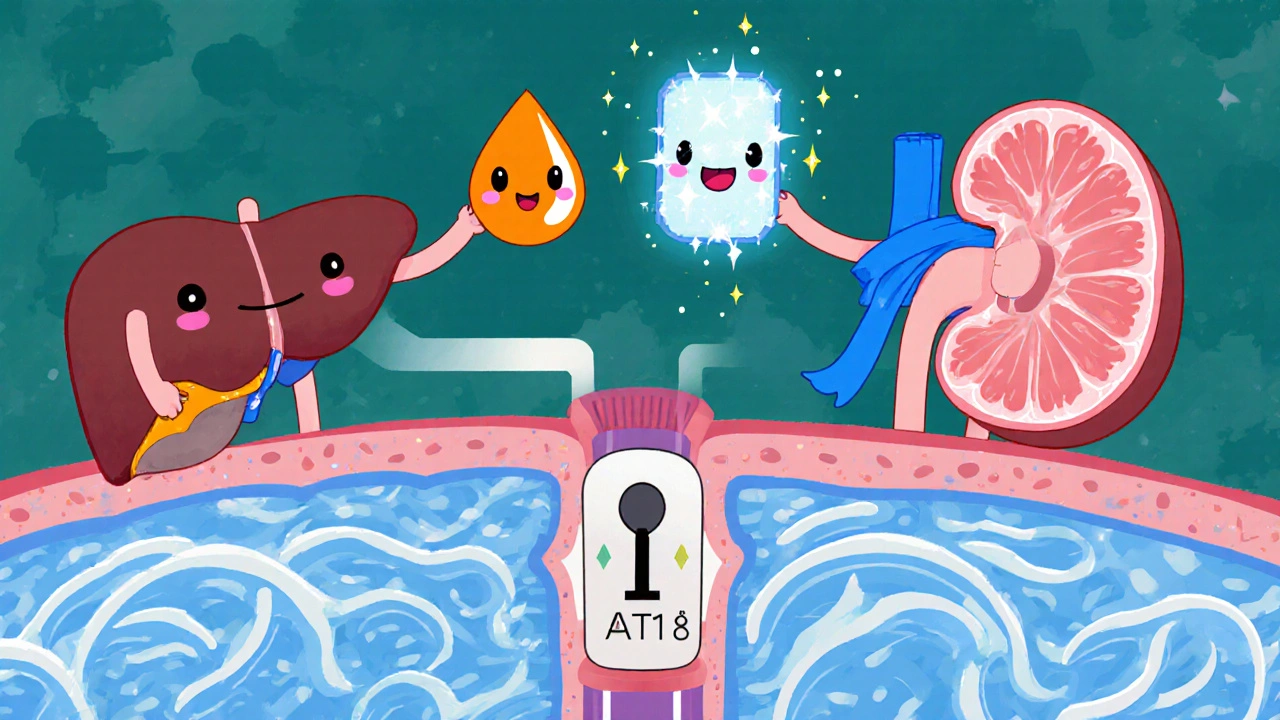ARB Comparison Tool
Compare Azilsartan with Other ARBs
Select an ARB to see how Azilsartan Medoxomil compares in potency, dosing, and side effects.
Azilsartan Medoxomil vs. [Selected ARB]
| Feature | Azilsartan | [Selected ARB] |
|---|---|---|
| Typical Dose | 40-80 mg | |
| Half-Life | 11-12 hours | |
| Systolic BP Reduction | 12-15 mmHg | |
| Common Side Effects | Dizziness, hyperkalemia | |
| Cough Risk | Low | Higher |
| 24-Hour Control | Excellent | |
| Kidney Protection | Proven |
Key Takeaways
Azilsartan provides stronger blood pressure reduction (12-15 mmHg) with once-daily dosing and fewer side effects compared to other ARBs.
When it comes to keeping blood pressure in check, Azilsartan Medoxomil is a relatively new player that’s turning heads. It belongs to the class of drugs called Angiotensin II Receptor Blockers (ARBs) and was approved in the United States in 2014. Since then, doctors have been spotting faster blood‑pressure drops, fewer side‑effects, and added kidney protection in patients who need tough‑as‑nails control.
What Makes Azilsartan Different?
Most ARBs sit on the same receptor - the AT1 receptor - and simply block angiotensin II from narrowing blood vessels. Azilsartan Medoxomil takes the same route but binds more tightly and stays attached longer. In pharmacology speak, it has a higher affinity and a longer half‑life (about 11‑12 hours) than older drugs like Losartan or Valsartan. That means you can often achieve the same BP reduction with a lower dose or once‑daily dosing, which translates into better adherence.
How Azilsartan Controls Blood Pressure
Understanding the Renin‑Angiotensin System (RAS) is key. The liver makes angiotensinogen, kidneys release renin, and the cascade ends with angiotensin II - the hormone that tells arteries to constrict. By blocking the AT1 receptor, Azilsartan stops this signal, letting vessels relax and blood pressure fall. The drug also reduces aldosterone secretion, which helps lower fluid retention - another contributor to high BP.
Top Benefits for Hypertension Management
- More potent BP lowering: Clinical trials show an average systolic reduction of 12‑15 mm Hg, slightly higher than many older ARBs.
- Consistent 24‑hour control: The long half‑life keeps pressure stable through the night, reducing “morning surge” spikes.
- Fewer cough complaints: Unlike ACE inhibitors, Azilsartan rarely triggers the dry cough that makes patients switch meds.
- Kidney‑friendly: Studies in diabetic nephropathy patients show slower eGFR decline compared with placebo.
- Simple dosing: Once‑daily tablet, no titration hassles for most adults.

How It Stacks Up Against Other ARBs
| Drug | Typical Dose (mg) | Half‑Life (hrs) | Systolic BP ↓ (mm Hg) | Common Side Effects |
|---|---|---|---|---|
| Azilsartan | 40-80 | 11‑12 | 12‑15 | Dizziness, hyperkalemia |
| Losartan | 50‑100 | 2‑2.5 | 8‑10 | Cough, headache |
| Valsartan | 80‑160 | 6‑9 | 9‑12 | Dizziness, fatigue |
| Olmesartan | 20‑40 | 13‑16 | 11‑13 | Diarrhea, muscle cramps |
Safety Profile and Tolerability
Overall, Azilsartan is well‑tolerated. The most common adverse events in Phase III trials were mild dizziness (about 5 %) and a slight rise in potassium levels. Serious events like angio‑edema are rare, mirroring the safety picture of other ARBs.
Key points to watch:
- Patients with severe renal impairment may need dose adjustments.
- Pregnant women should avoid ARBs altogether - they can harm fetal kidney development.
- Concurrent use with potassium‑sparing diuretics can push potassium too high; routine labs are recommended.

Practical Tips for Patients and Clinicians
- Start low, go slow: Most guidelines suggest 40 mg once daily for adults, increasing to 80 mg if BP isn’t at target after 2‑4 weeks.
- Check labs at baseline and after 4‑6 weeks: serum creatinine, eGFR, and potassium.
- Take the tablet with or without food - consistency helps avoid missed doses.
- Combine with lifestyle changes: DASH diet, regular walking, and reduced sodium intake boost results.
- If switching from another ARB, a direct 1:1 conversion is usually safe, but monitor BP for the first week.
Frequently Asked Questions
What is the typical dose of Azilsartan for adults?
The usual starting dose is 40 mg once daily. If blood pressure remains above goal after 2-4 weeks, many clinicians increase to 80 mg daily.
Can Azilsartan be used in people with diabetes?
Yes. In fact, trials show that Azilsartan may slow kidney function loss in diabetic patients, making it a solid choice for this group.
How does Azilsartan compare to ACE inhibitors?
Both lower blood pressure, but ACE inhibitors often cause a dry cough (up to 20 % of users). Azilsartan, like other ARBs, avoids that side‑effect while offering comparable BP control.
Is Azilsartan safe during pregnancy?
No. All ARBs are contraindicated in pregnancy because they can impair fetal kidney development and lead to birth defects.
What should I do if I miss a dose?
Take the missed tablet as soon as you remember, unless it’s almost time for the next dose. In that case, skip the missed one and continue with the regular schedule. Never double‑dose.
Bottom Line
If you’re looking for an ARB that delivers solid blood‑pressure drops, works round the clock, and carries a low cough risk, azilsartan medoxomil deserves a spot on the treatment list. Its potency, once‑daily simplicity, and emerging kidney‑protective data make it a compelling option for many adults battling hypertension.

Alex Pegg
October 20, 2025 AT 16:53Azilsartan may look shiny, but the hype ignores the bigger picture of drug pricing in America. While the article praises its potency, the cost per tablet often eclipses that of generic losartan, putting a strain on patients who already struggle with insurance coverage. Moreover, the claim of “kidney‑friendly” benefits is still based on limited subgroup analyses, not on hard‑won long‑term outcomes. We need to be skeptical of any new ARB that promises a miracle without robust, independent data. In short, the drug is another example of the pharmaceutical industry repackaging old mechanisms for profit.
laura wood
October 20, 2025 AT 17:10I appreciate the clear summary of how Azilsartan works.
Rajesh Myadam
October 20, 2025 AT 17:26For many patients, especially those juggling diabetes, the added kidney protection can be a game‑changer. Still, it’s crucial to monitor potassium and kidney labs regularly, as the article rightly points out. The once‑daily dosing is a practical advantage for adherence, and the lower incidence of cough compared with ACE inhibitors can improve quality of life. Ultimately, a shared decision with the clinician remains key.
Andrew Hernandez
October 20, 2025 AT 17:43Azilsartan once daily fits busy schedules and avoids the cough issue common with ACE inhibitors
Deja Scott
October 20, 2025 AT 18:00The table nicely compares half‑life and dose ranges, making it easy to see where Azilsartan stands among its peers.
Mahesh Upadhyay
October 20, 2025 AT 18:16Listen up-if you think all ARBs are the same, think again. Azilsartan locks onto the AT1 receptor tighter, giving you that extra systolic drop. It’s not magic, but it does mean fewer pills. Just don’t ignore the potassium checks.
Kate McKay
October 20, 2025 AT 18:33Great rundown! Remember, lifestyle changes like the DASH diet and regular walks amplify any medication’s effect, so keep those habits in place. If you start at 40 mg and don’t hit target, the step up to 80 mg is usually well‑tolerated. Keep an eye on your labs and stay in touch with your provider-consistency is the secret sauce.
Demetri Huyler
October 20, 2025 AT 18:50One must admit, the article presents Azilsartan with a flourish that borders on reverence, yet it glosses over the nuanced pharmacoeconomic debates that underpin modern hypertension therapy. While the author extols its “potent BP lowering,” the broader discourse invites skepticism: does a marginally greater mm Hg reduction justify the premium price tag in a cost‑conscious healthcare system? Moreover, the implication that a longer half‑life automatically translates to superior adherence ignores patient heterogeneity and the reality of polypharmacy. In the grand tapestry of antihypertensives, Azilsartan is a noteworthy thread, but not the singular solution some would have you believe.
JessicaAnn Sutton
October 20, 2025 AT 19:06Azilsartan’s pharmacodynamic profile, characterized by a high affinity for the AT1 receptor and an extended elimination half‑life, undeniably distinguishes it from earlier agents such as losartan and valsartan. Nevertheless, the purported superiority in systolic reduction must be contextualized within the heterogeneity of trial populations, many of which were enriched for moderate to severe hypertension. The cited average decline of 12‑15 mm Hg, while statistically significant, may not translate to a clinically meaningful difference for patients already achieving target pressures with lower‑cost generics. Furthermore, the safety data, albeit reassuring regarding cough incidence, reveal a modest uptick in hyperkalemia, a concern especially pertinent to individuals with concomitant renal impairment or potassium‑sparing diuretics. The article’s brief mention of eGFR preservation in diabetic nephropathy warrants a deeper examination of long‑term renal outcomes, as short‑term surrogate markers can be misleading. Cost considerations also loom large; the wholesale acquisition cost of azilsartan often exceeds that of its generic counterparts, potentially imposing a financial burden on patients without demonstrable incremental benefit. From a mechanistic standpoint, the blockade of aldosterone secretion contributes to reduced fluid retention, yet this effect is not unique to azilsartan and is shared by other ARBs. The recommendation for baseline and follow‑up laboratory monitoring aligns with standard practice, but adherence to such protocols remains variable in real‑world settings. In addition, the cautionary stance on pregnancy is appropriate, mirroring class‑wide contraindications, yet the article could have emphasized the importance of a swift therapeutic switch in women of child‑bearing age. The discussion of “once‑daily simplicity” overlooks the reality that adherence is multifactorial, encompassing patient education, health literacy, and socioeconomic determinants. Moreover, while the drug’s longer half‑life may mitigate nocturnal blood pressure surges, the clinical significance of this observation is still under investigation. The table comparing azilsartan with other ARBs provides a clear snapshot; however, it omits considerations such as drug‑drug interactions, which can be clinically relevant in polypharmacy. In clinical practice, patient preference for pill burden often sways medication choice, and azilsartan’s single‑tablet regimen can be appealing. Nevertheless, prescribers must weigh this convenience against the drug’s marginal efficacy edge and higher expense. Thus, integrating azilsartan into therapy should be a deliberate, case‑by‑case decision rather than a blanket substitution.
Israel Emory
October 20, 2025 AT 19:23Azilsartan certainly adds a useful tool to the hypertension toolbox, but let’s not pretend it’s a panacea; the drug’s longer half‑life can improve nocturnal control, yet clinicians must vigilantly monitor potassium, especially when patients are also on potassium‑sparing agents; moreover, the cost differential demands a frank conversation with patients about value versus expense, and the occasional dizziness reported in trials should not be dismissed as trivial, because even minor side effects can affect adherence, so a comprehensive, individualized approach remains paramount.